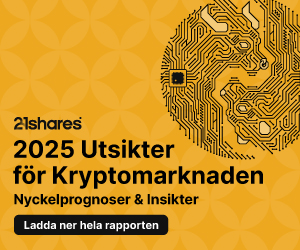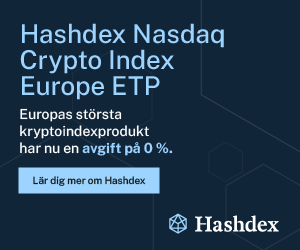Nyheter
Cryptoassets of the Month: November 2023
Publicerad
1 år sedanden
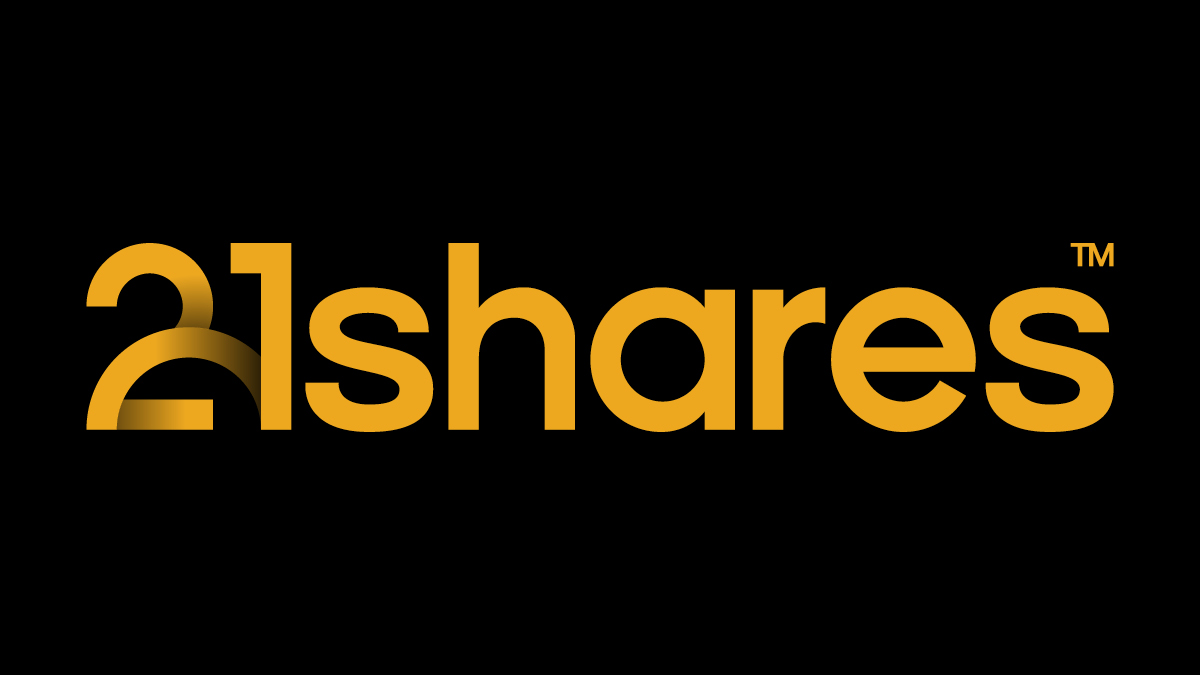
Every month, 21Shares research team will present the cryptoassets of the month that increased or dropped in value by more than 15%. With a data-driven approach, we highlight the most important developments and events causing price movements.
Figure 1 – 30-Day Performance: Cryptoassets of the Month vs. Traditional Asset Classes

Source: 21Shares, CoinGecko, and Yahoo Finance, from 31-Oct-2023 to 30-Nov-2023 (Close Price)
Avalanche (AVAX)

Avalanche’s native token AVAX traded up 88.87% over the past month as a narrative around growing institutional adoption of the platform has been getting traction. On November 16, Ava Labs’ AvaCloud, a launchpad that allows businesses to deploy custom, fully managed blockchains using an intuitive no-code portal, was used by Citi to price and execute simulated bilateral spot foreign-exchange (FX) trades on-chain. In addition, JP Morgan and Apollo Global announced a collaborative effort leveraging a permissioned Avalanche Evergreen Subnet to build an on-chain portfolio management solution. Both proofs of concept are part of the Monetary Authority of Singapore’s (MAS) Project Guardian.
Solana (SOL)

Solana (SOL) rallied 63.77% in November as on-chain activity exploded. In November, trading volume on Solana’s decentralized exchanges (DEXs) hit an all-time high of $7.3 billion. The current wave of ”airdrops” across Solana’s applications is a critical factor contributing to the rise in on-chain activity. Pyth Network – an oracle that provides a variety of price feeds for apps – airdropped PYTH tokens to over 100k users on Solana. Other notable applications like Jupiter (JUP), a DEX aggregator offering unique features such as limit orders and dollar-cost averaging, or Jito (JTO), a liquid staking provider that accrues both staking and MEV rewards, have confirmed upcoming airdrops. Undoubtedly, the wealth effect of meaningful airdrops to the community can have a reflexive impact on Solana’s ecosystem, similar to what Ethereum experienced during the summer of 2020.
Uniswap (UNI)

Uniswap (UNI) rose 43.37% over the past month. On October 17, Uniswap Labs – core contributors of the Uniswap protocol – began charging a 0.15% swap fee on specific tokens in their web interface and mobile wallet. Since then, Uniswap Labs has accrued more than $1.8 million through the fee mechanism, which is highly promising for the sustainability and long-term development of the decentralized exchange. On another note, Thalos, a technology provider for institutions to trade digital assets, partnered with Uniswap Labs to provide its clients with the deepest liquidity venue in DeFi. The partnership will expand opportunities for clients to achieve the best trade execution as they can seamlessly tap into centralized and decentralized liquidity venues.
Chainlink (LINK)

Chainlink (LINK) rallied 38.35% over the past month. Regarding fundamentals, Chainlink Staking v0.2 went live on November 28, with a pool size capped at 45 million LINK. The upgrade is designed to improve the security of the Chainlink network by introducing new features, such as slashing (i.e., losing a portion of the principal staked balance due to being deemed a ”bad actor” on the network). In other words, slashing creates a negative incentive to prevent node operators from behaving maliciously. Another crucial addition of Staking v0.2 is the introduction of a dynamic rewards mechanism that can support new external sources of revenue in the future, such as user fees. For instance, stakers could accrue a portion of the >$150k that Chainlink has generated thanks to CCIP in the past five months.
Lido (LDO)

Lido (LDO) rose 28.42% over the past month. On November 27, the Lido DAO approved the deployment of the ”Distributed Validator Technology” or Simple DVT Module. Rather than relying on a single node operator, DVT relies on multiple node operators, each managing distinct nodes that communicate and collectively reach consensus to fulfill validator responsibilities. As such, it represents a crucial step in significantly enhancing the protocol’s decentralization, distribution, and resilience. Lido estimates it could see over 200 net new operators by Q2 2024, from just 35 today. Regarding fundamentals, Lido’s staked ETH grew 5.23% from 8.80 million on October 31 to 9.26 million ETH (~$19 billion) on November 30. Lido retains 10% of staking rewards, registering ~$6.18 million in revenue in November, and is on track to surpass $60 million in annual revenue for 2023.
Cardano (ADA)
Cardano’s native token ADA traded up 28.10% over the past month. Despite its positive price performance, Cardano’s fundamentals have stayed the same, with only 35.5k daily active users as of November 30, 2023, a fraction of competing smart contract platforms like Solana (384k) and Polygon (329k). Cardano must offer differentiated applications to attract new users and bridge the education gap for developers to learn the Haskell programming language, which is the basis of Cardano’s native smart contract language, Plutus. If we observe the derivatives market, ADA funding rates have been increasing consistently since October, suggesting that many traders are positioned to the upside.
Fantom (FTM)

Fantom’s native token FTM rose 25.71% over the past month. Fantom’s total value locked (TVL) – a crypto-native metric akin to assets under management – was sitting at ~$61 million as of November 30, 2023, still down 99% from its peak in February 2022. Fantom is still struggling to attract liquidity, especially after the Multichain bridge hack in July 2023, which resulted in a ~$120 million loss for the ecosystem. It remains to be seen whether the mainnet launch of Fantom Sonic, the network’s latest upgrade expected to enhance Fantom’s throughput to 2,000 transactions per second (TPS), has any material impact on the user demand for the network.
Polkadot (DOT)

Polkadot’s native token DOT increased by 22.65% over the past month. On November 24, Polkadot welcomed a new parachain to its ecosystem dubbed “Logion.” The application-specific blockchain aims to solve one of the critical challenges with tokenization today – a legal framework for the transfer of ownership. In other words, how to ensure that a token transfer means transferring the ownership of the underlying asset? Logion is operated by a network of judicial officers who must verify the source and integrity of tokenized assets, which are issued by verified counterparties. It remains to be seen whether Logion can succeed in its mission, but it’s positive to see experimentation on this front.
Algorand (ALGO)

Algorand’s native token ALGO rose 22.04% over the past month. On November 14, blockchain firm Quantoz Payments was granted a license as an electronic money institution (EMI) under the supervision of the Dutch Central Bank and was permitted to issue a regulated euro-pegged stablecoin (EURD) on the Algorand network. EURD must have a strong distribution plan to gather sufficient growth as the stablecoin space has become highly competitive. For instance, industry leaders Tether and Circle launched euro-backed stablecoins a while back, and both products have struggled to gain traction, with just about $50 million in market cap for each, compared to their U.S. dollar-pegged counterparts ($23.5 billion for USDC and $90 billion for USDT).
Aave (AAVE)

Aave (AAVE) rallied 20.62% over the past month. In response to an attack vector reported by a white hat (ethical security hacker), core developers took immediate steps to protect the Aave protocol by pausing and freezing the affected markets on November 4. No funds were affected, and an additional proposal was then submitted to disable the stable borrow rate for all assets across all pools on all networks and unfreeze assets. Regarding on-chain metrics, Aave’s decentralized stablecoin grew ~24% in November to 34.8 million GHO in circulation. GHO got within 2% of its $1 peg on November 28 after trading almost 5% below it for most of the month due to a lack of holding demand.
Polygon (MATIC)

Polygon’s native token MATIC traded up 19.77% over the past month. As part of the Polygon 2.0 roadmap, the upgrade to POL token upgrade was initiated on the Ethereum mainnet after months of development. The migration from MATIC to POL is expected to occur early in 2024. Regarding on-chain insights, Polygon’s total value locked (TVL) decreased by almost 10%, as measured in MATIC throughout November, from 1.211 to 1.095 billion. On the other hand, the trading volume on decentralized exchanges rose ~39%, from $3.53 billion in October to $5.81 billion in November, the highest figure since March 2023.
Decentraland (MANA)

Decentraland (MANA) rose 18.93% despite a sharp drop in platform usage. About 1,550 unique wallet addresses interacted with Decentraland throughout November, a ~55% decrease from October. The virtual world has struggled to gain user traction since the peak in activity in 2021. On another note, the Decentraland Foundation announced the first-ever community conference, which will take place in Argentina in May 2024. This initiative may be an excellent opportunity to forge better relationships and a deeper bond with creators and users, as exclusively focusing on virtual events has not had the desired effects on platform growth.
The Sandbox (SAND)

The Sandbox (SAND) traded up 18.04% in November. Like Decentralan’s situation, The Sandbox has struggled to gain user traction, a worrying trend for metaverse projects. About 5,550 unique wallet addresses interacted with the virtual world throughout November, down 65% from October. At this point, it’s fair to conclude that the notable partnerships that The Sandbox struck with recognizable names in 2021 and 2022, such as TIME, Lionsgate, or Snoop Dogg, had little material impact on the long-term growth of the project.
Cosmos (ATOM)

The Cosmos Hub’s native token ATOM rose 16.50% in the past month. On November 25, ATOM’s maximum annual inflation was reduced from 20% to 10% in a close community vote. Those favoring the proposal argued that the Cosmos Hub has overpaid for the network’s security. Another crucial argument was that the high historical inflation has damaged the perception of ATOM’s monetary premium throughout the ecosystem. In contrast, the biggest detractor of the proposal was Cosmos’ co-founder Jae Kwon, who now plans to launch a Cosmos fork dubbed ”AtomOne.” Throughout crypto’s history, contentious hard forks of this type have arisen due to disagreement within a network’s community. The risks of a controversial hard fork are significant, as stakeholders (validators, developers, users) must choose which blockchain they will support when it splits and two are created. Based on the governance forum’s discussions, Kwon’s influence has waned in the community, and most will likely continue supporting the Cosmos Hub, now more unified than ever.
Ethereum (ETH)

Ethereum rose 12.93% over the past month. ETH’s net issuance was negative in November, with a decrease of ~29k ETH in circulating supply, alongside an increase in the amount of ETH burned, a sign that the cryptoasset’s prospects as a deflationary asset depend heavily on network usage. Regarding fundamentals, the amount of staked ETH closed the month at 28.69 million ETH, equivalent to ~$59 billion securing the network. Lido remains the leader in market share, with ~32% of total staked ETH distributed across 35 node operators. Finally, Ethereum remains crypto’s most profitable protocol, registering $238 million in transaction fees during November.
Bitcoin (BTC)

Bitcoin traded up 8.77% over the past month. Regarding the derivatives market, the CME surpassed Binance in BTC futures open interest for the first time in history, with $4.04 billion in notional value as of November 30, 2023. The rise in CME open interest is a testament to the demand for regulated financial products from institutions to gain exposure to Bitcoin. In terms of network activity, fees accrued to miners increased by more than six times from $21.03 million in October to $142.5 million in November. The surge results from new use cases on the network, like Ordinals NFTs, which continue to gain traction. This trend has eased many investors’ concerns regarding the long-term security of the network.
Strategies of the Month: November 2023
Every month, our research team will also present the ten best-performing strategies of the month in our product suite. With a data-driven approach, we highlight the most important developments and events causing price movements.
Figure 2: 30-Day Performance: Strategies of the Month vs. Traditional Asset Classes
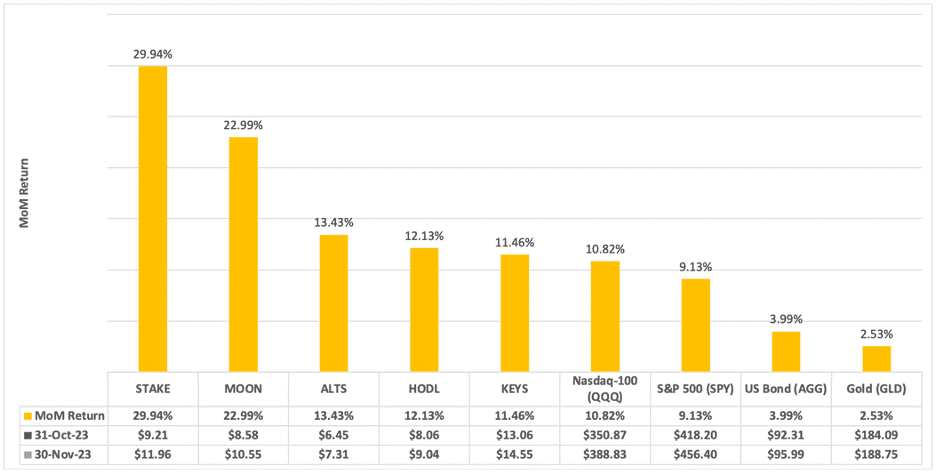
Data Source: 21Shares Data Hub and Yahoo Finance, from 31-Oct-2023 to 30-Nov-2023 (Close Price)
STAKE

The 21Shares Staking Basket Index ETP (STAKE) traded up 29.94% over the past month. STAKE seeks to track an index comprising the largest cryptoassets with institutional-grade support for staking. Staking is a process whereby investors, commonly referred to as validators, commit a portion of their cryptoassets (the “stake”) to secure a blockchain by confirming transactions – and gain access to a recurring value stream of native tokens to compensate them for their work. Staking is a core energy-friendly feature of Proof-of-Stake (PoS) blockchains, and each blockchain network has its own set of staking requirements. SOL remains the index’s largest constituent with a weight of 33.64% after strong price performances in October and November.
MOON

The Sygnum Platform Winners Index ETP (MOON) rose 22.99% over the past month. MOON seeks to track the investment results of an index composed of the native tokens of the most prominent blockchain protocols, including only the largest network in a family of forks. MOON’s weighting methodology goes beyond backward-looking metrics like market cap and liquidity. It also includes early and leading indicators of value creation in the underlying ecosystems, such as developer engagement and public interest via social media.
ALTS

The 21Shares Crypto Mid-Market Index ETP (ALTS) appreciated 13.43% over the past month. ALTS seeks to track the investment results of an index capturing the mid-cap portion of the cryptoasset market. BNB and XRP are the largest constituents of the index with weights of ~26% and ~24%, respectively. BNB underperformed the broader crypto market with an almost flat performance (0.45%), likely due to Binance’s ~$4 billion settlement with the Department of Justice (DOJ) and subsequent change in leadership.
HODL

The 21Shares Crypto Basket Index ETP (HODL) traded up 12.13% over the past month. HODL seeks to track the investment results of an index of the top 5 cryptoassets ranked by the 2050 market capitalization. The 2050 market capitalization is calculated using a projected 2050 supply number and current prices. Bitcoin and Ethereum’s weights are currently around 52% and 29%, respectively. Bitcoin’s weight in the index has increased over the past month due to its relative outperformance compared to other constituents like ETH, XRP, and DOT.
KEYS

The 21Shares Bitwise Select 10 Large Cap Crypto ETP (KEYS) rose 11.46% over the past month. KEYS seeks to track the investment results of an index of the top 10 cryptoassets ranked by inflation-adjusted market capitalization. Because Bitcoin and Ethereum’s weights in the index represent about 91%, the index’s performance tends to be highly correlated with both assets, as was the case over this period.
Research Newsletter
Each week the 21Shares Research team will publish our data-driven insights into the crypto asset world through this newsletter. Please direct any comments, questions, and words of feedback to research@21shares.com
Disclaimer
The information provided does not constitute a prospectus or other offering material and does not contain or constitute an offer to sell or a solicitation of any offer to buy securities in any jurisdiction. Some of the information published herein may contain forward-looking statements. Readers are cautioned that any such forward-looking statements are not guarantees of future performance and involve risks and uncertainties and that actual results may differ materially from those in the forward-looking statements as a result of various factors. The information contained herein may not be considered as economic, legal, tax or other advice and users are cautioned to base investment decisions or other decisions solely on the content hereof.
Du kanske gillar
-
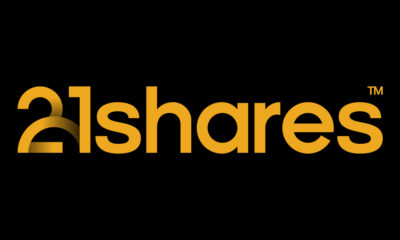

Michael Saylor’s bold Bitcoin bet and Strategy’s risk analysis
-


US regulatory shift provides a beacon for optimism
-
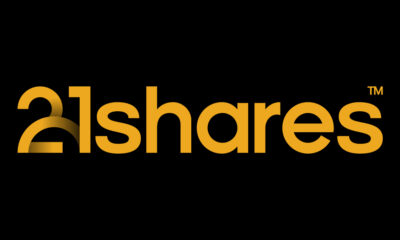

21Shares ringer i klockan på Nasdaq Stockholm
-
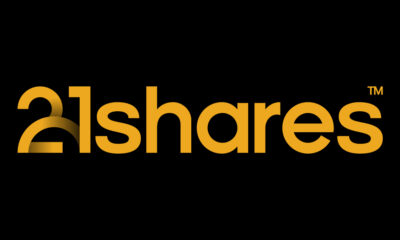

Crypto Market Risks & Opportunities: Insights on Bybit Hack, Bitcoin, and Institutional Adoption
-


WisdomTree sänker avgiften för fysisk Bitcoin ETP till 0,15 %
-
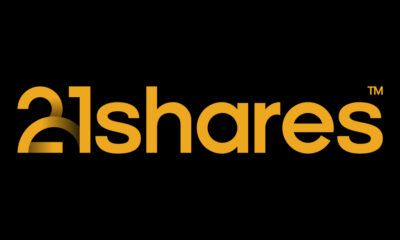

Bitcoin’s strength beneath the surface
Nyheter
Crypto’s political tailwinds are blowing hard: Lessons from a week in Washington
Publicerad
15 minuter sedanden
3 april, 2025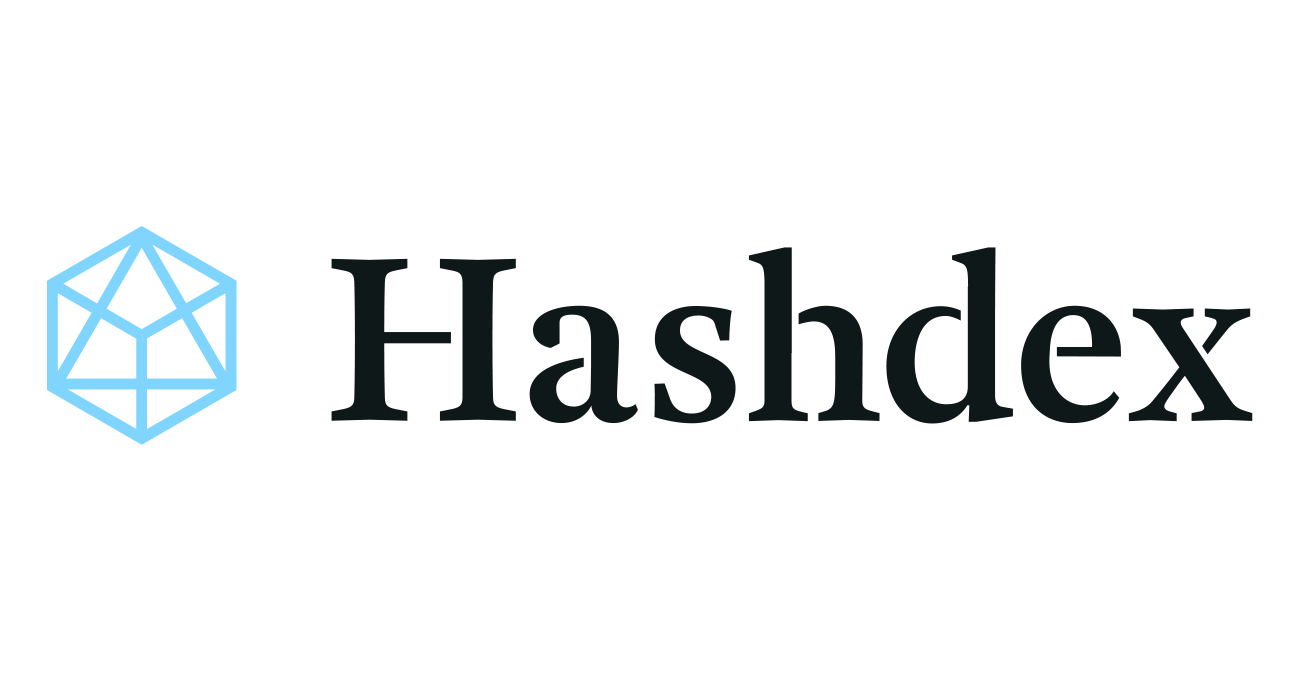
Last week, I was in Washington, DC to attend the DC Blockchain Summit and to meet with regulators and policymakers to share our experiences as a crypto-focused asset manager over the last seven years.
The Summit, hosted by The Digital Chamber, included speeches from dozens of members of Congress, regulators, and industry leaders. After listening to presentations and speaking with a number of regulators and policymakers I have one key takeaway: Regulatory clarity for crypto will come much faster than I previously anticipated.
A dramatic shift in tone
As I wrote in January, US policymakers and government leaders—at nearly every level—are embracing this technology. For years, the lack of clear rules for digital assets in the US has been a major obstacle for institutional investors and financial firms looking to enter the crypto space. However, this past week in DC, as well as several of the conversations I’ve had with advisors and wealth managers over the last several weeks, has left me with an even higher sense of optimism.
One of the most striking takeaways from my meetings was the shift in how policymakers are discussing crypto. Just a year ago, many in Washington viewed digital assets primarily through the lens of risk—concerns over fraud, illicit finance, and speculative volatility dominated the conversation. While these concerns still exist, the discussions now are much more nuanced and focused on the opportunities that crypto can create to the American economy and how to address these risks through a clear regulatory framework.
Bipartisan support for legislation
Perhaps the most encouraging sign is the concrete progress being made on both legislative and regulatory fronts. Several key developments indicate that clearer guidelines for crypto businesses and investors could arrive sooner than expected. There is growing bipartisan momentum behind crypto-related legislation. The House Financial Services Committee and the Senate Banking Committee are moving forward with stablecoin legislation, and it is possible legislation could be signed into law as early as this summer. Stablecoins have also been a key focus of regulatory discussions, with growing consensus that they should be subject to clear guidelines similar to those governing payment systems and money market funds.
House and Senate committees are also actively discussing proposals that aim to define the jurisdiction of regulatory agencies, clarify the status of digital assets, and establish consumer protections. Unlike previous years, these efforts are being taken seriously by both parties, increasing the likelihood of meaningful legislative progress.
Adding to these regulatory discussions is the growing demand for crypto exposure from institutional investors. This demand is influencing policymakers and regulators, as they recognize that a lack of clarity is pushing innovation overseas.
What does this shift mean for investors?
The acceleration of regulatory clarity is a significant development for investors. While the approval of spot bitcoin ETFs last year was a watershed moment, it’s just the beginning. Several large financial institutions, including major banks and asset managers, are actively exploring tokenization, digital asset custody, and blockchain-based financial infrastructure. These institutions are engaging with regulators, advocating for a clear framework that allows them to enter the market with confidence.
Uncertainty has been one of the biggest barriers to broader crypto adoption by financial institutions and institutional investors in particular. As regulations become clearer this year, we expect to see:
• Increased institutional participation: With regulatory uncertainty diminishing, more traditional financial institutions will feel comfortable offering crypto products and using crypto technologies such as stablecoins to offer more efficient services, driving further mainstream adoption.
• Growth in tokenization and blockchain use cases: Clearer regulations will pave the way for asset tokenization, improving efficiency in markets like real estate, bonds, and private equity.
• A stronger US crypto market: By establishing a clear regulatory framework, the US can assert itself as a global financial leader, which we believe will help spur more regulatory clarity in other jurisdictions.
Final thoughts
The message from Washington is clear: crypto regulation is coming, and it’s coming faster than many expected. While there are still hurdles to overcome, the shift from uncertainty to structured regulation is well underway. For investors, this marks an important transition. Clearer rules will reduce risks, enhance market stability, and unlock new opportunities for institutional and retail participants alike.
At Hashdex, we remain committed to navigating these changes and providing investors with access to the best opportunities in this evolving landscape. As we move forward, continued engagement with regulators, policymakers, and financial institutions will be key. The crypto industry has a critical role to play in shaping the future of regulation, and by working collaboratively, we can help ensure that the next phase of crypto’s growth is built on a foundation of clarity and trust.
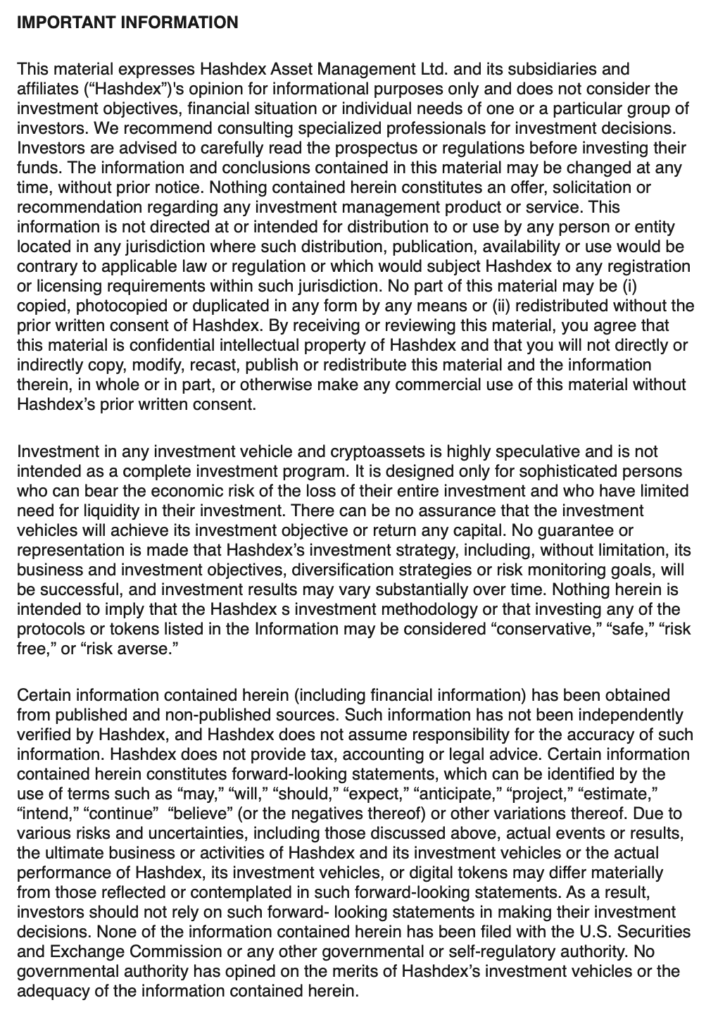

Sprott Physical Uranium ETC (SPUT ETC), med ISIN XS2937253818, är utformad för att erbjuda investerare ett effektivt sätt att få tillgång till prisutvecklingen hos fysiskt uran.
För att uppnå detta innehar Sprott Physical Uranium ETC, som strävar efter att ge exponering mot priset för fysiskt uran, före avgifter och utgifter, genom att hålla fysiska lager hos tre olika leverantörer.
Den börshandlade produktens TER (total cost ratio) uppgår till 0,55 % p.a. Denna ETC replikerar resultatet av det underliggande indexet med en skuldförbindelse med säkerheter som backas upp av fysiska innehav av den underliggande metallen.
Sprott Physical Uranium ETC lanserades den 27 februari 2025 och har sin hemvist på Jersey.
Caset för en fysiskt uran ETC
Obalans mellan utbud och efterfrågan på uran kommer sannolikt att växa: Den växande efterfrågan på kärnenergi överträffar uranproduktionen, som hämmades av historiskt låga priser, och därmed begränsade nya projekt. Detta kan skapa en gynnsam miljö för stigande uranpriser.
Ny tjurmarknad för uran potentiellt under utveckling: Befintligt utbud kanske inte möter framtida efterfrågan, vilket uppmuntrar köpare av icke-nyttigt uran att komma in på marknaden. Verktygen förväntas påskynda inköpen av uran för att säkerställa långsiktig pris- och leveranssäkerhet.
Uran ger pålitlig och ren baslastkraft: Kärnenergi levererar konstant, ren elektricitet dygnet runt, vilket gör den till en kritisk kraftkälla när den globala energiförbrukningen fortsätter att växa.
Produktinformation
| Lanseringsdatum | 27/02/2025 |
| Basvaluta | USD |
| TER | 55 bps |
| Replikeringsmetod | Fysisk replikering |
| Hemvist | Jersey |
| ISIN | XS2937253818 |
Viktiga risker
Priset på uran kan vara volatilt och kan gå upp och ner. När du investerar i en ETC är ditt kapital helt i riskzonen. Investerare kanske inte får tillbaka det belopp de ursprungligen investerade. Uran- och kärnkraftsindustrin kan påverkas av förändringar i politiken/statliga regleringar, säkerhetsbrott, illvilliga terrordåd eller naturkatastrofer. Även om Sprott Physical Uranium Trust har för avsikt att följa det föreslagna investeringsmålet, garanterar emittenten inte fondens resultat.
Handla SPUT ETC
Sprott Physical Uranium ETC (SPUT ETC) är en europeisk börshandlad råvara. Denna ETP handlas på flera olika börser, till exempel Deutsche Boerse Xetra och London Stock Exchange.
Det betyder att det går att handla andelar i denna ETC genom de flesta svenska banker och Internetmäklare, till exempel Nordnet, SAVR, DEGIRO och Avanza.
Börsnoteringar
Nyheter
VanEck ETF utökar sitt kryptoerbjudande med Celestia ETN
Publicerad
21 timmar sedanden
2 april, 2025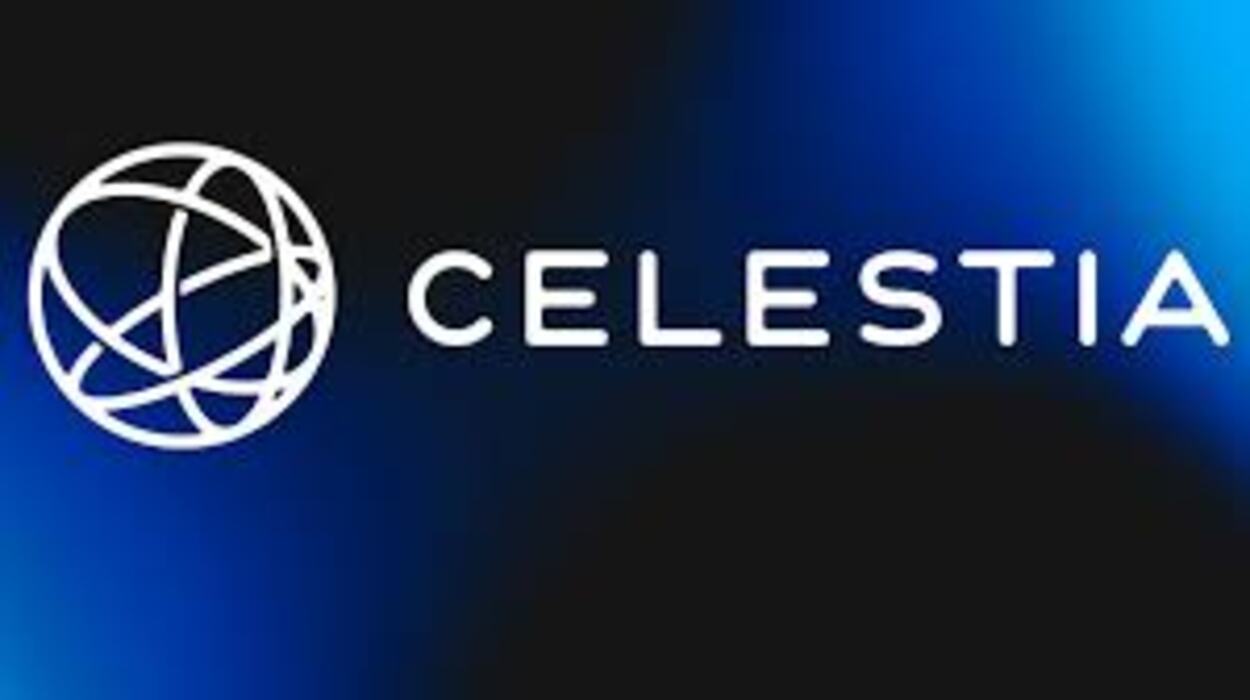
Idag tillkännagav kapitalförvaltaren VanEck ETF noteringen av VanEck Celestia ETN på Euronext Amsterdam och Euronext Paris.
- Celestia möjliggör säker skalning av blockchain-applikationer
- Modularitet tillåter utvecklare att bygga och skala nya blockkedjor med lätthet
- VanEck Celestia ETN är tillgängligt i följande länder: Österrike, Schweiz, Tyskland, Danmark, Spanien, Finland, Frankrike, Italien, Liechtenstein, Luxemburg, Nederländerna, Norge, Polen, Portugal och Sverige
Detta börshandlade certifikat (ETN) gör det möjligt för investerare att delta i utförandet av TIA-tokenet i en investerarföredraget omslag. TIA-token är Celestia-nätverkets ursprungliga kryptovaluta.
Celestia är ett specialiserat blockchain-nätverk designat för att optimera och skala datatillgänglighet, branschens grundläggande skalningsflaskhals. Detta gör det möjligt för utvecklare att enkelt distribuera applikationer i sitt eget blockutrymme med hög genomströmning med full-stack-kontroll.
”Efterfrågan på TIA-token är ett direkt resultat av behovet av Celestias tjänster, eftersom alla interaktioner på Celestia är denominerade och betalda i TIA,” förklarade Menno Martens, Crypto Product Manager på VanEck Europe. ”När fler och fler utvecklare använder Celestias tjänster för att bygga fullstackapplikationer med hög genomströmning, ser vi tillväxtpotential för Celestia.”
VanEck Celestia ETN erbjuder investerare ett reglerat och börshandlat sätt att få exponering för denna innovativa blockchain. Investerare bör dock notera risken för extrem volatilitet i samband med digitala tillgångar.
”VanEcks ETN är ett av de första stegen mot utökad tillgång till Celestia av institutioner”, säger Mustafa Al-Bassam, medgrundare av Celestia och ordförande för Celestia Foundation. ”Snart kommer det att finnas fler sätt att gå med i Celestias ekosystem för alla typer av användare och deltagare.”
Denna ETN spårar MarketVector Celestia VWAP Close Index, som återspeglar priset på TIA-token. Den är helt säkerställd, vilket innebär att de underliggande tillgångarna faktiskt köps och förvaras säkert i kylförvaring. VanEck samarbetar med Bank Frick, ett reglerat förvaringsinstitut i Liechtenstein, för att säkerställa höga standarder för förvaring av kryptovaluta över sina ETNer.
Produktinformation
| Namn | VanEck Celestia ETN |
| Indexnamn | MarketVector Celestia VWAP Close Index |
| ISIN | DE000A4AKZB4 |
| Kortnamn | VTIA |
| Registerade länder | AT, CH, DE, DK, ES, FI, FR, IT, LI, LU, NL, NO, PL,PT, SE |
| Ticker Euronext Amsterdam | VTIA NA |
| Ticker Euronext Paris | VTIA FP |
| Indexleverantör | MarketVector Indexes GmbH |
| Total expense ratio (TER) | 1,5 % |

Crypto’s political tailwinds are blowing hard: Lessons from a week in Washington

SPUT ETC spårar priset på uran

VanEck ETF utökar sitt kryptoerbjudande med Celestia ETN

B4NZ ETC en eurohedgad satsning på WTI Crude

XZEP ETF köper aktier i företag i Europa med höga ESG-betyg

Fonder som ger exponering mot försvarsindustrin

WisdomTree lanserar europeisk försvarsfond.

Warren Buffetts råd om vad man ska göra när börsen kraschar

De bästa börshandlade fonderna för tyska utdelningsaktier

Trumps återkomst får europeiska aktier att rusa
Populära
-

 Nyheter2 veckor sedan
Nyheter2 veckor sedanFonder som ger exponering mot försvarsindustrin
-

 Nyheter3 veckor sedan
Nyheter3 veckor sedanWisdomTree lanserar europeisk försvarsfond.
-

 Nyheter1 vecka sedan
Nyheter1 vecka sedanWarren Buffetts råd om vad man ska göra när börsen kraschar
-

 Nyheter3 veckor sedan
Nyheter3 veckor sedanDe bästa börshandlade fonderna för tyska utdelningsaktier
-

 Nyheter3 veckor sedan
Nyheter3 veckor sedanTrumps återkomst får europeiska aktier att rusa
-

 Nyheter3 dagar sedan
Nyheter3 dagar sedanSvenskarna har en ny favorit-ETF
-
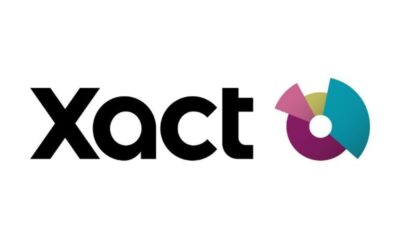
 Nyheter4 veckor sedan
Nyheter4 veckor sedanUtdelning i XACT Norden Högutdelande mars 2025
-

 Nyheter2 veckor sedan
Nyheter2 veckor sedanHANetf lanserar Europa-fokuserad försvars-ETF


